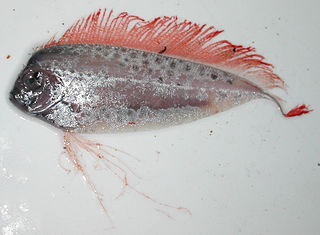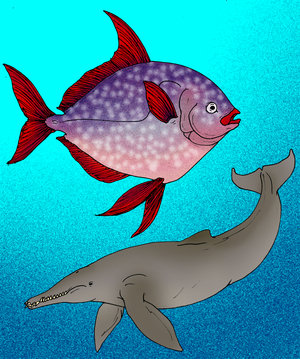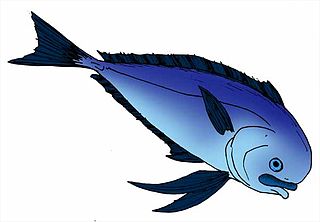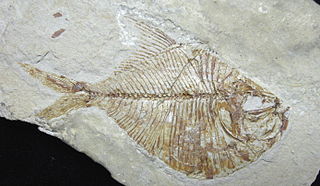
The Tethys Ocean, also called the Tethys Sea or the Neo-Tethys, was a prehistoric ocean during much of the Mesozoic Era and early-mid Cenozoic Era. It was the predecessor to the modern Indian Ocean, the Mediterranean Sea, and the Eurasian inland marine basins.
Lampriformes is an order of ray-finned fish. Members are collectively called lamprids or lampriforms, and unite such open-ocean and partially deep-sea Teleostei as the crestfishes, oarfish, opahs, and ribbonfishes. A synonym for this order is Allotriognathi, while an often-seen, but apparently incorrect, spelling variant is Lampridiformes. They contain seven extant families which are generally small but highly distinct, and a mere 12 lampriform genera with some 20 species altogether are recognized. They are the only extant members of the superorder Lamprimorpha, which was formerly diverse throughout much of the Late Cretaceous.

Opahs, also commonly known as moonfish, sunfish, kingfish, and redfin ocean pan are large, colorful, deep-bodied pelagic lampriform fishes comprising the small family Lampridae.

The ribbonfish are any lampriform fishes in the family Trachipteridae. These pelagic fish are named for their slim, ribbon-like appearance. They are rarely seen alive, as they typically live in deep waters, though are not bottom feeders. The perciform fish known as the red bandfish is sometimes referred to as ribbonfish, but it is unrelated to any ribbonfish in the Trachipteridae.

Archaeus is an extinct genus of marine jackfish from the Paleogene of Europe, where it inhabited the former Tethys Ocean. The oldest species, A. oblongus is from the early Ypresian epoch of Eocene Turkmenistan, and the last species, A. glarisianus and A. solus, are from the early to middle Rupelian, of the Oligocene lagerstatten of Canton Glarus, Switzerland and the Pshekha Formation of North Caucasus, Russia.

Crestfishes, family Lophotidae, are lampriform fishes found in most oceans. It consists of two extant and four extinct genera.

The Paratethys sea, Paratethys ocean, Paratethys realm or just Paratethys was a large shallow inland sea that stretched from the region north of the Alps over Central Europe to the Aral Sea in Central Asia.
Dussumieriidae is a family of clupeiform fishes popularly called the "round herrings". It is now recognized by FishBase as a family in its own right; it had been considered to be a subfamily of Clupeidae. It contains two extant genera, and some potential fossil genera. Possibly the earliest record of the group is Nardoclupea from the Campanian of Italy.

Bathysoma is an extinct genus of marine lampriform ray-finned fish from the early-mid Paleocene. It contains a single species, B. lutkeni from Sweden. Its fossils are common in exposures of the Danian København Limestone Formation at Limhamns kalkbrott, one of the largest quarries in northern Europe. A single specimen is also known from an erratic boulder from the Selandian Lellinge Greensand Formation of southern Sweden.

Megalampris keyesi is an extinct opah from the late Oligocene of New Zealand about 26 million years ago. It was recovered from the Otekaike Limestone in North Otago, by a team led by Ewan Fordyce from the Geology Department of the University of Otago. The species is named in honour of the New Zealand palaeontologist Ian Warwick Keyes (1938-2004). It is the largest fossil teleost fish from New Zealand, the spectacular remains comprise three large limestone blocks containing mostly caudal skeleton. These are on display in the Otago Museum, Dunedin, New Zealand. Some of the vertebral centra preserved are 90 mm across. Comparison with the skeletons of living Lampris species suggest the giant fish was around 4 metres (13 ft) in length when alive, which is twice the length of the largest living opah species, Lampris guttatus. The cleithra in the fossil are significantly enlarged to suggest that Megalampris used the pectoral swimming mode characteristic of moonfishes.

Analectis pala is an extinct lamprid of the family Turkmenidae, of which it was the last surviving member. Its fossils are found from Early Oligocene strata of the Krasnodar Krai, Russia. Analectis, as with the other members of Turkmenidae, was a close relative of the opahs. An indeterminate lamprid with potential affinities to it is known from the early Eocene of Denmark.

Danatinia casca is an extinct lamprid from Danata Formation Lagerstatten, of the Upper Paleocene of Turkmenistan. It was first named by Daniltshenko in 1968.

Turkmene finitimus is an extinct lamprid from the Danata Formation Lagerstatten, of the Upper Paleocene of Turkmenistan. It lived sympatrically with its close relative, Danatinia.
Aipichthyoides is an extinct genus of prehistoric marine bony fish that lived during the lower Cenomanian in what is now the West Bank. Formerly classified in the Polymixiiformes, it is now thought to be a distant relative of oarfish and opahs.
Berycomorus is an extinct genus of prehistoric marine ray-finned fish that lived during the late Eocene epoch. It contains a single species, B. firdoussi, from the Pabdeh Formation of Iran.

Aluvarus praeimperialis is an extinct ray-finned fish, known from two headless fossil specimens found in the Pabdeh Formation, a Late Eocene stratum from the Priabonian epoch, of what is now Iran. A. praeimperialis was originally thought to be a luvar, described as "Luvarus praeimperialis", as it was thought to be a predecessor to the modern luvar. A later reexamination of the specimens showed that they were too incomplete to demonstrate such a conclusion and had no clear exclusive shared traits with luvar, and were renamed "Aluvarus", meaning "not luvar" or "different than luvar". However, some authorities still retain it as a luvar.

Anaethalion is an extinct genus of prehistoric marine and freshwater ray-finned fish related to modern tarpons and ladyfish. It is known from the Late Jurassic to the Early Cretaceous of Europe and northeasterrn Asia, roughly encompassing the Tethys Ocean.
The Danata Formation is an earliest Eocene to Middle Eocene sedimentary succession located in Turkmenistan. It is mostly famous for its fish-bearing horizons (Ichthyofauna). The formation for example crops out in the Kopet Dag mountain range in the border region of Turkmenistan and Iran.

The Ellimmichthyiformes, also known as double-armored herrings, are an extinct order of ray-finned fish known from the Early Cretaceous to the Oligocene. They were the sister group to the extant true herrings, shad and anchovies in the order Clupeiformes, with both orders belonging to the suborder Clupeomorpha.

Lamprimorpha is a superorder of marine ray-finned fishes, representing a basal group of the highly diverse clade Acanthomorpha. Represented today only by the order Lampriformes, recent studies have recovered other basal fossil species of the group dating as far back as the Cenomanian stage of the Late Cretaceous. Some of these fossil taxa, such as the paraphyletic genus Aipichthys, are among the oldest known fossil acanthomorphs, and overall they appear to have been a major component of the marine fish fauna at that time. Lamprimorpha is thought to be the sister group to the superorder Paracanthopterygii, which contains cod, dories, and trout-perches.















